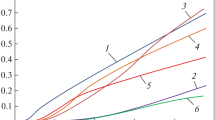Abstract
The characteristics of erosion pits on a carbon steel surface were investigated at the incipient stage of cavitation erosion. After a 5-minute experiment performed in an ultrasonic vibration system, needle-like erosion pits appeared on the polished steel surface, and a specially affected zone was formed around the pit. The shape of the pit and the plastic deformation of the affected zone indicate that the mechanical impaction on the surface is the main reason for the cavitation damage. On the other hand, the iridescent color, the decreased surface hardness and the precipitated carbides on the affected zone prove that the affected zone has experienced a tempering process with the temperature higher than 300°C. The lack of oxygen in the affected zone also proves that it is not a chemical oxygen result. A special phenomenon that a carbon ring forms in the affected zone is explained as a result of the toroidal bubbles’ heating effect at the final stage of the bubble collapse.
Similar content being viewed by others
References
Hammit F G. Cavitation and Multiphase Flow Phenomena. New York: McGraw-Hill, 1980. 241
Plesset M S, Bubble D. Cavitation in Real Fluids. New York: Elsevier Publishing Co., 1964
Nowotny H. Destruction of Materials by Cavitation. Berlin: VDI-Verlag, 1942
Gavranek V V, Bol’shutkin D N, Zel’dovich V I. Thermal and mechanical action of a cavitation zone on the surface of a metal. Fiz Metal I Metalloved, 1960, 10: 262–268
Wu C C, Robert P H. Shock-wave propagation in a sonoluminescence gas bubble. Phys Rev Lett, 1993, 70(22): 3424–3427
Ying C F, An Y. High temperature and high pressure distribution in gas bubbles generated by sound cavitation. Sci China Ser A-Math, 2002, 45(7): 926–936
Knapp R T, Daily J W, Hammit F G. Cavitation. New York: McGraw — Hill, 1970
Knapp R T. Recent investigations of cavitation and cavitation damage. Trans ASME, 1955, 77: 1045–1054
Plesset M S, Ellis A T. On mechanism of cavitation damage. Trans ASME, 1955, 77: 1055–1064
Wang Z C, Zhang Y, Zhang X Q. Thermal effect of cavitation erosion. Chin J Mater Res, 2001, 15(3): 287–290
Gregory E, Simons N. The Heat-Treatment of Steel. London: Pitman & Sons, Ltd., 1958
Best J P. The formation of toroidal bubbles upon the collapse of transient cavities. J Fluid Mech, 1993, 251: 79–107
Zhang S, Duncan J H, Chahine G L. The final stage of the collapse of a cavitation bubble near a rigid wall. J Fluid Mech, 1993, 257: 147–181
Author information
Authors and Affiliations
Corresponding author
Additional information
Supported by the National Natural Science Foundation of China (Grant No. 50505020) and the National Basic Research Program of China (Grant No. 2007CB707702)
About this article
Cite this article
Chen, H., Li, J., Liu, S. et al. Affected zone generated around the erosion pit on carbon steel surface at the incipient stage of vibration cavitation. Chin. Sci. Bull. 53, 943–947 (2008). https://doi.org/10.1007/s11434-008-0105-z
Received:
Accepted:
Published:
Issue Date:
DOI: https://doi.org/10.1007/s11434-008-0105-z




